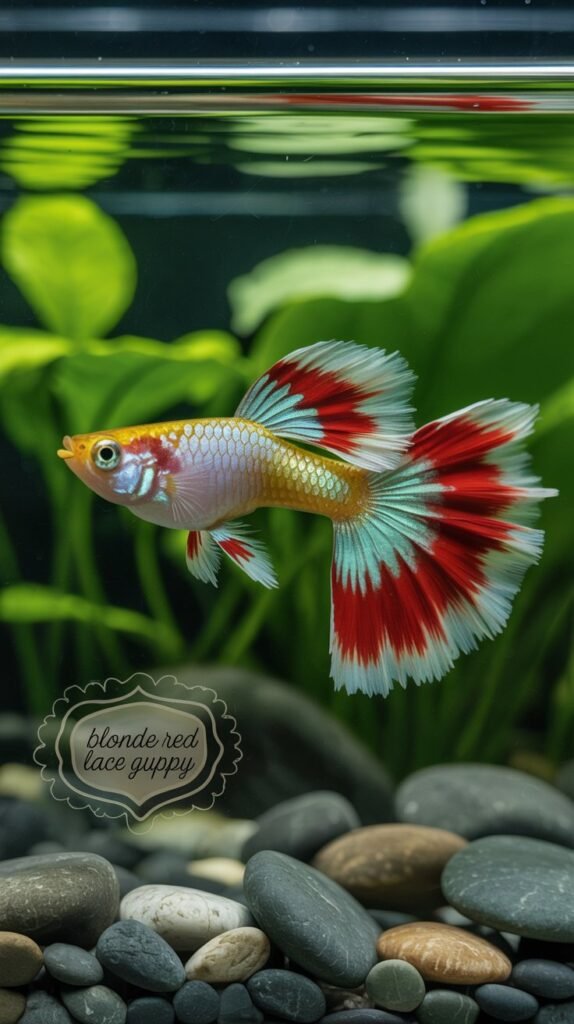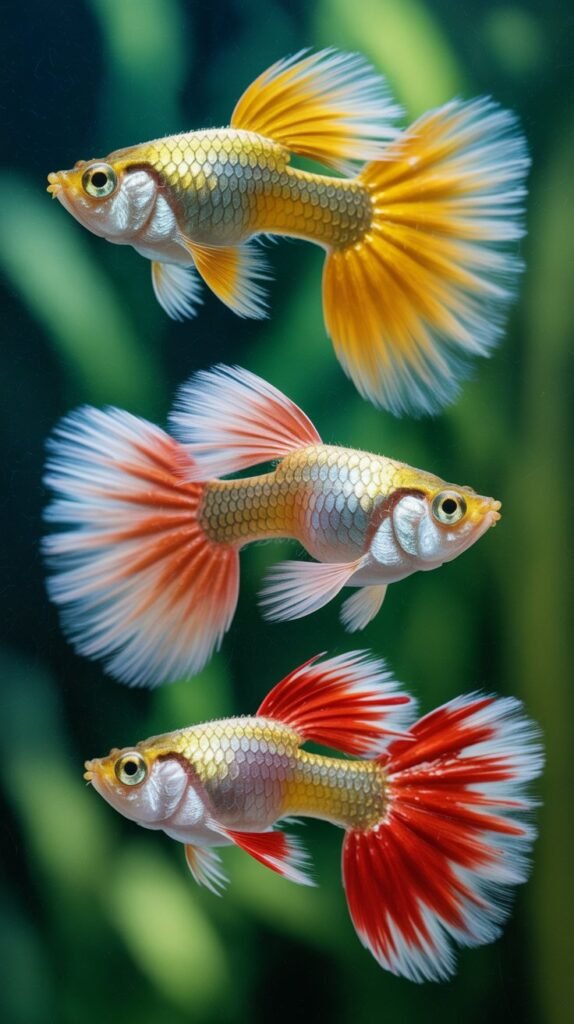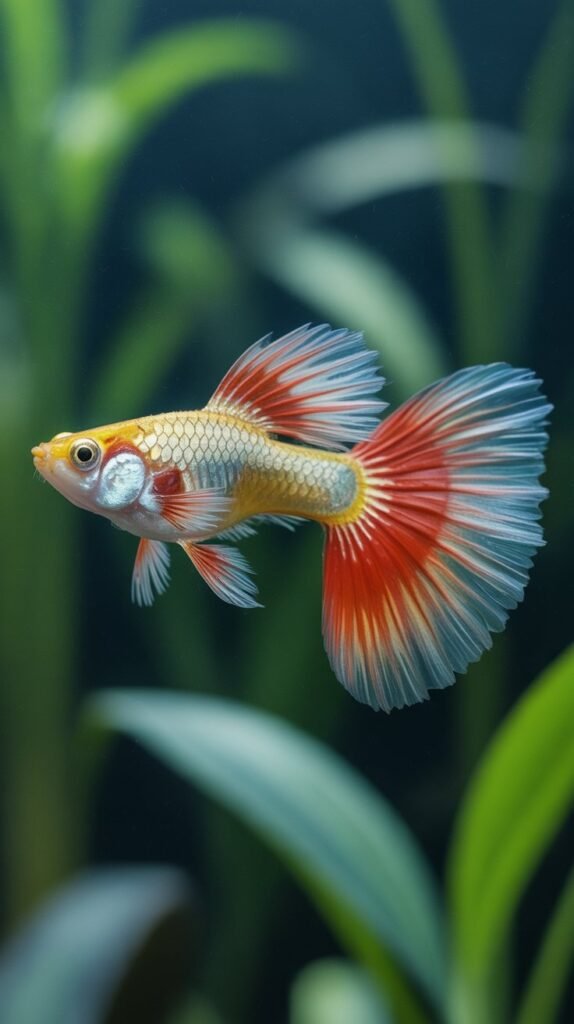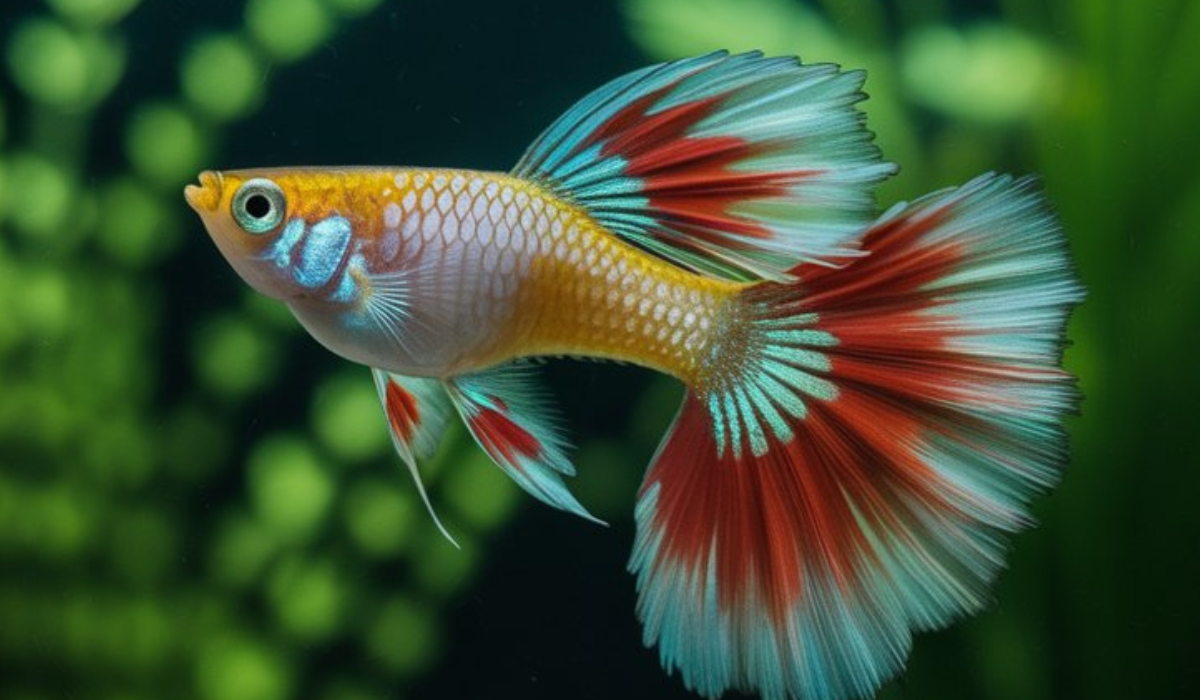Guppies are one of the most popular freshwater fish in the aquarium hobby, prized for their vibrant colors, fascinating patterns, and easy care. Among the many guppy varieties, the Blonde Red Lace Guppy stands out as a truly stunning and elegant strain. With its delicate lace-like tail pattern combined with a fiery red hue and a lighter blonde body base, this guppy is a showpiece in any aquarium.
Whether you are a beginner aquarist or a seasoned breeder, the Blonde Red Lace Guppy is an excellent choice thanks to its adaptability, hardiness, and beauty. In this in-depth guide, we’ll cover everything you need to know about keeping, breeding, and caring for this magnificent guppy strain.
Introduction to the Blonde Red Lace Guppy
The Blonde Red Lace Guppy is a selectively bred strain of Poecilia reticulata, the common guppy. It is characterized by:
- Body Base: A pale golden or blonde coloration that enhances the vibrancy of other colors.
- Tail Pattern: A lace-like reticulated pattern on the caudal fin, giving it a net-like appearance.
- Color Highlight: A striking red coloration that usually dominates the tail and sometimes extends to the body.
This combination of blonde base + red lace tail creates a mesmerizing contrast, making them highly sought after by aquarists and breeders.
Origins and Breeding Background

Guppies have been selectively bred for over a century, resulting in hundreds of color morphs and fin variations. The Blonde Red Lace Guppy originates from cross-breeding guppies with blonde body genes (which dilute dark pigmentation) and guppies with the red lace pattern.
The blonde gene reduces melanin, resulting in a lighter body that allows bright colors like red and orange to appear more vibrant. The lace pattern is a fine, intricate net-like design, often appearing in black over a red or yellow background. When combined, breeders produced the Blonde Red Lace strain—one of the most elegant guppies available.
Appearance and Characteristics
The Blonde Red Lace Guppy is admired for its graceful and colorful appearance.
- Size: Males reach about 1.5–2 inches, while females grow slightly larger at 2–2.5 inches.
- Body Shape: Slender males with vibrant coloration, and larger, rounder females with subtler colors.
- Fins: Long, flowing caudal and dorsal fins, covered in lace-like patterns.
- Colors: Blonde (golden) body base with vibrant red tail and intricate lace designs in black or dark brown.
- Sexual Dimorphism: Males are more colorful, while females are paler and larger.
Why Choose the Blonde Red Lace Guppy?
There are many reasons hobbyists love this guppy strain:
- Stunning Aesthetics – The combination of red, gold, and lace makes them stand out in aquariums.
- Peaceful Nature – Ideal for community tanks with other small, non-aggressive fish.
- Hardy Fish – Can tolerate a wide range of water conditions.
- Breeding Potential – Perfect for hobby breeders who want to maintain or improve strain quality.
- Active Swimmers – Constantly swimming, adding life and motion to the tank.
Tank Requirements for Blonde Red Lace Guppies
Although they are hardy, providing optimal tank conditions ensures vibrant colors, longer lifespans, and better breeding.
1. Tank Size
- A minimum of 10 gallons for a small group.
- Larger tanks (20–30 gallons) are recommended for breeding colonies.
2. Water Parameters
- Temperature: 74–82°F (23–28°C)
- pH: 6.8–7.8
- Hardness: 8–12 dGH
- Keep conditions stable, as fluctuations can stress guppies.
3. Filtration
- Use a sponge filter or hang-on-back filter.
- Avoid overly strong currents, as guppies prefer calm water.
4. Substrate and Decorations
- Dark substrate enhances their colors.
- Live plants such as Java moss, hornwort, and guppy grass provide hiding places and breeding grounds.
- Add driftwood and rocks for a natural look.
5. Lighting
- Moderate lighting enhances their colors and supports plant growth.
Tank Mates for Blonde Red Lace Guppies

Guppies are peaceful and do well with other non-aggressive community fish.
Good Tank Mates:
- Neon Tetras
- Harlequin Rasboras
- Endler’s Livebearers
- Corydoras Catfish
- Mollies
- Shrimp (Cherry, Amano)
- Snails
Avoid:
- Aggressive species like Bettas, Tiger Barbs, and Cichlids.
Feeding Blonde Red Lace Guppies
These guppies are omnivores and require a balanced diet for health and vibrant colors.
- Staple Diet: High-quality flakes or micro pellets.
- Live/Frozen Foods: Daphnia, brine shrimp, bloodworms, mosquito larvae.
- Vegetable Matter: Spirulina flakes, blanched spinach, cucumber, and zucchini.
- Algae: They naturally graze on algae in the tank.
Feeding Frequency: Small amounts 2–3 times daily. Avoid overfeeding to prevent water pollution.
Breeding Blonde Red Lace Guppies
Breeding guppies is one of the most rewarding aspects of fishkeeping, and the Blonde Red Lace variety is no exception.
1. Courtship and Mating
- Males actively pursue females, showing off their fins.
- They use a gonopodium (modified anal fin) for fertilization.
2. Gestation Period
- Lasts about 25–30 days.
- Females develop a gravid spot near the anal fin.
3. Fry Birth
- A single brood produces 20–40 fry.
- Fry are free-swimming immediately.
4. Protecting Fry
- Adult guppies may eat their own fry.
- Use breeding boxes or provide dense plant cover (Java moss).
- Feed fry infusoria, powdered flakes, or baby brine shrimp.
5. Selective Breeding
To maintain or enhance the Blonde Red Lace strain:
- Breed only the best-colored males and females.
- Separate fry to avoid uncontrolled crossbreeding.
Common Health Issues

Even though guppies are hardy, they may encounter health problems if not properly cared for.
- Ich (White Spot Disease) – Caused by parasites, seen as white grains on the body.
- Fin Rot – Bacterial infection leading to frayed fins.
- Velvet Disease – Gold-dust appearance on the skin.
- Swim Bladder Issues – Caused by poor diet or constipation.
- Fungal Infections – Cotton-like growths on fins or body.
Prevention:
- Keep water clean with weekly water changes.
- Avoid overfeeding.
- Quarantine new fish before adding them to the tank.
Tips for Keeping Blonde Red Lace Guppies Healthy
- Perform 25–30% weekly water changes.
- Keep a male-to-female ratio of 1:2 or 1:3 to prevent female stress.
- Avoid overcrowding the tank.
- Offer a varied diet for optimal color and health.
- Maintain stable water parameters.
Blonde Red Lace Guppy vs. Other Lace Guppies
- Red Lace Guppy: Richer red coloration without the blonde body base.
- Blue Lace Guppy: Similar lace pattern but with blue tones.
- Golden Lace Guppy: Similar to blonde, but with deeper golden tones.
- Albino Lace Guppy: Red eyes with a paler, almost white body.
The Blonde Red Lace is unique due to its combination of a lighter body base and fiery red lace tail, making it particularly striking.
Common Mistakes to Avoid
- Mixing with aggressive fish – Can cause stress and fin damage.
- Poor diet – Leads to dull colors and weak immune systems.
- Ignoring fry – Adults may eat them without proper hiding spaces.
- Overcrowding – Causes stress, disease outbreaks, and aggression.
- Neglecting water changes – Accumulated toxins can quickly harm guppies.
Conclusion
The Blonde Red Lace Guppy is a breathtaking addition to any aquarium, offering a combination of elegance, activity, and vibrant color. With proper care, stable water parameters, and a nutritious diet, these guppies will thrive and reproduce, providing endless enjoyment for aquarists.
Whether you are a casual hobbyist or a dedicated breeder, the Blonde Red Lace Guppy is an excellent choice that combines beauty and ease of care.
FAQs About Blonde Red Lace Guppies
1. What makes Blonde Red Lace Guppies unique?
Their blonde body base and red lace-patterned tail set them apart from other guppy strains.
2. How big do Blonde Red Lace Guppies get?
Males reach about 1.5–2 inches, while females grow to 2–2.5 inches.
3. Are they good for beginners?
Yes, they are hardy, adaptable, and easy to breed, making them perfect for beginners.
4. How long do they live?
They typically live 2–3 years with proper care.
5. Do they need a heater?
Yes, if your room temperature falls below 74°F.
6. Can they live with shrimp?
Yes, they coexist well with peaceful shrimp species like Cherry or Amano shrimp.
7. How often do they breed?
Females can give birth every 4–6 weeks, producing 20–40 fry per batch.
8. Do they need special food?
No, but they thrive on a varied diet of flakes, live, and vegetable-based foods.
9. Are they prone to diseases?
Like all guppies, they can suffer from common fish diseases if water conditions are poor.
10. Can they be kept in a small tank?
Yes, but a minimum of 10 gallons is recommended for a small group.

